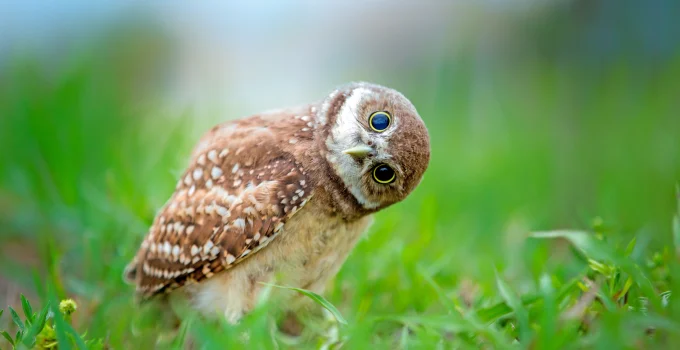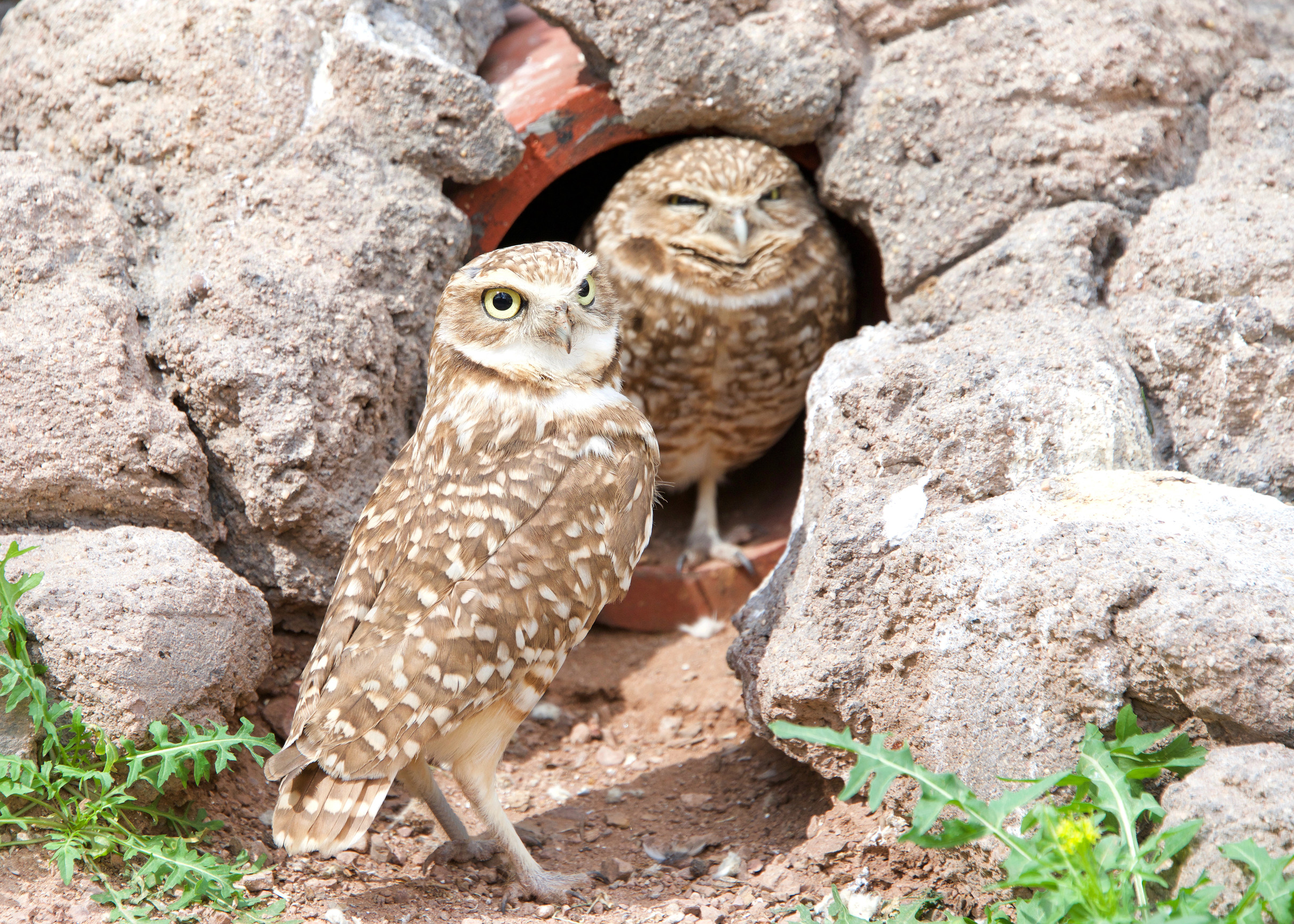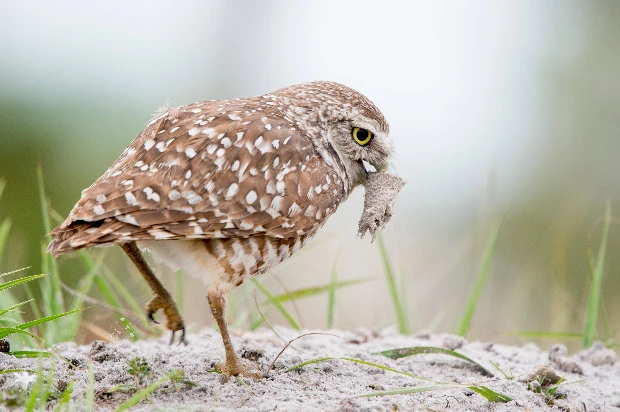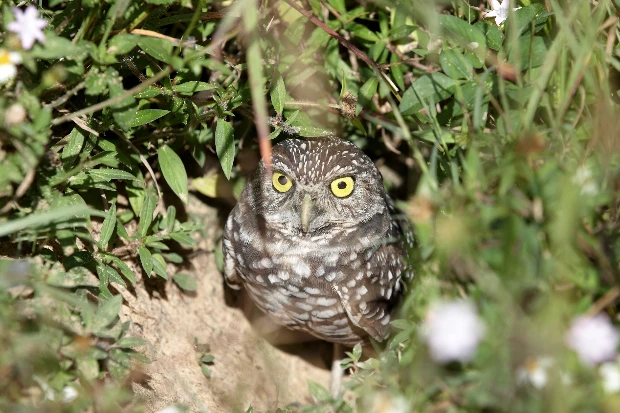Burrowing Owl Fun Facts
Discover answers to the most popular questions about burrowing owls, including classification, identification, habitat and range, hunting and diet, behavior, and conservation status.
Classification
How Are Burrowing Owls Classified?
Phylum: Chordata
Subphylum: Vertebrata
Class: Aves
Order: Strigiformes
Family: Strigidae
Genus: Athene
Species: Athene cunicalaria
Identification
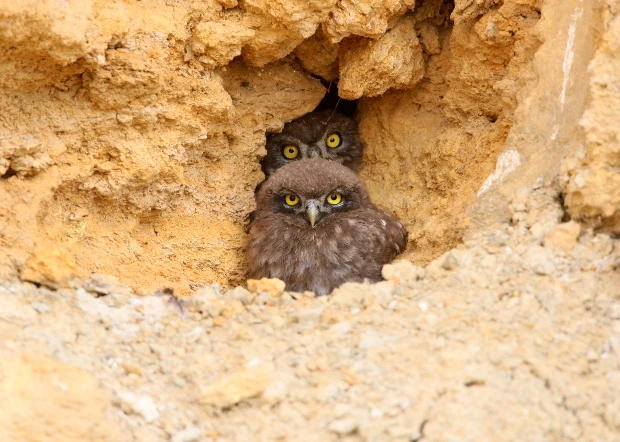
What Does a Burrowing Owl Look Like?
The burrowing owl is brown with white spots, the perfect camouflage for its environment among the trees. A line of feathers resembling eyebrows highlights its bright eyes. One of the standout features of this little cutie is its long, lanky legs.
How Big Is a Burrowing Owl?
The burrowing owl is one of the smallest owl species, measuring 7.5-9.8 inches in length and weighing 6 ounces. (The only smaller owls are the Pygmy Owl or Elf Owl). Its two-foot wingspan is TINY when compared to a larger owl species like the Snowy Owl, which has a wingspan of almost five feet. [1]
Unlike other owl species, where the female is larger than the male, both sexes are of the same size. [2]
Habitat and Range
Are Burrowing Owls Only Found in the United States?
Burrowing owls are widely distributed throughout the United States, their range extending from the east coast to the western Canadian provinces.
Although the burrowing owl is abundant on the plains of the Midwest, it can also be found outside the United States. The owl’s range is from the Pacific coast of North America, expanding east to Minnesota and Louisiana. It can be seen as far north as British Columbia and Manitoba and as far south as Tierra del Fuego. It can also be found in parts of Florida and a few Caribbean islands during the breeding season. [3]
Where Do Burrowing Owls Nest?
Burrowing owls nest in hollow burrows in the ground, hence the name. They can dig a burrow by standing on one foot and scratching the surface with the other (dirt in pellets suggests they may use their bills to excavate as well); however, they often prefer to inhabit the abandoned dwellings of other burrowing animals, such as prairie dogs. They will then personalize the burrow, elongating it if necessary, and line the nesting chamber with grass, feathers, and weeds. These tunnels are often five feet long and will turn a corner along the length to conceal the nesting chamber at the end of the tunnel. [4][5]
Burrowing owls are more colonized than many other owl species, nesting within loose colonies about 100 yards apart. [6]
Hunting and Diet
What Do Burrowing Owls Eat?
But large insects make up a good portion of their diet. They are particularly fond of large beetles and locusts and are known to feed on scorpions as well. [7]
Owls do not digest food in the same manner that we do. They swallow their food whole, and the parts that they cannot digest, such as bones, teeth, and fur, are compacted into pellets and coughed up. [8]
How Do Burrowing Owls Catch Their Prey?
The burrowing owl employs various hunting strategies depending on the type of prey it is targeting. They sometimes take flight and hover over an area, searching for suitable prey. They also still hunt from an elevated position, waiting to locate prey or to catch an insect as it flies within range. It can also use its long, lanky legs to scurry after its prey. It has a shorter tail than most other owl species, which allows it to accommodate ground hunting. [9]
Do Burrowing Owls Have Predators?
Being primarily ground-bound, this tiny owl is in danger from many predators, including horned owls, foxes, badgers, hawks, and even domestic pets. [10]
The burrowing owl exhibits several interesting survival instincts. For example, it lines its burrow with cow or horse manure, which is believed to mask the smell of the owl from predators. It has been observed that the removal of manure at the entrance to the burrow results in its immediate replacement within a day. [11] It can also mimic the rattle of the prairie rattlesnake when threatened. [12]
Behavior
Are Burrowing Owls Nocturnal?
Burrowing owls are primarily diurnal. They socialize and hunt during the day. In fact, among all owl species, this group is most often sighted due to its daytime behaviors. But that doesn’t mean that these cute creatures sleep at night. Their calls can be heard throughout the evening, especially during mating season. [13]
These owls may prefer to hunt during the day because their eyesight is not as keen compared with other owl species. In an experiment on the keenness of owl sight, the barn owl could locate a mouse at 2,000 feet with the light of only one candle. On the other hand, the burrowing owl found it challenging to find prey even when additional light sources were added. [14]
Do Burrowing Owls Migrate?
Burrowing owls are non-migratory. They will live in one area for their entire lives. Some movement may occur if the environment ceases to provide adequate prey. [15]
Though not all burrowing owls migrate, it is generally accepted that they are a migratory species in the northern part of their range. Several observational studies have hypothesized that the disappearance of some owls during colder seasons may result from the birds caching food and settling into their burrows. [16]
Conservation Status
Are Burrowing Owls Endangered?
Burrowing Owls are listed as ‘endangered’ in Canada and ‘threatened’ in Mexico. The US Fish and Wildlife Service considers them a ‘bird of conservation need’ at the national level. At the state level, burrowing owls are listed as ‘endangered’ in Minnesota, ‘threatened’ in Colorado and Florida, and as a ‘species of concern’ in California, Montana, Oklahoma, Oregon, Utah, Washington, and Wyoming. [17]
References
- [1][2][17] US Fish & Wildlife Service – “Burrowing Owl (Athene cunicularia).”
- [3][5][7][14] Burton, Maurice, and Robert Burton. International Wildlife Encyclopedia. 3rd ed. New York: Marshall Cavendish, 2002. Print.
- [4][9][11][15][16] Ryser, Fred A., and Jennifer Dewey. Birds of the Great Basin: a natural history. Reno: University of Nevada Press, 1985. Print.
- [6][10] Defenders of Wildlife – “Fact Sheet-Burrowing Owls.”
- [8] National Audobon Society – “What Is an Owl Pellet?”
- [12][13] Scholz, Floyd, and Tad Merrick. Owls, Mechanicsburg, PA: Stackpole Books, 2001. Print.
